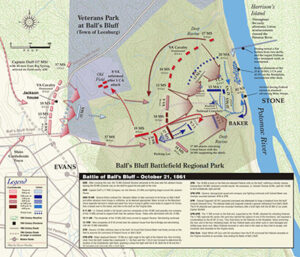A BGES Civil War Field University Program
With Gary Ecelbarger and Scott Patchan
August 14-17, 2025; from Manassas, VA
 Undoubtedly, the second, third, and fourth years of the Civil War are the most studied and toured period of the great American conflict. This has opened the latter half of 1861 as a prime area for fresh focus––six months of campaigns that set the stage for a ramped-up war that followed. Northern Virginia hosted the largest battle fought on American soil during the first twelve months of the war, a monstrous affair along the banks of Bull Run.
Undoubtedly, the second, third, and fourth years of the Civil War are the most studied and toured period of the great American conflict. This has opened the latter half of 1861 as a prime area for fresh focus––six months of campaigns that set the stage for a ramped-up war that followed. Northern Virginia hosted the largest battle fought on American soil during the first twelve months of the war, a monstrous affair along the banks of Bull Run.
Exactly three months later and 30 miles north of Manassas, the Battle of Ball’s Bluff produced a great Confederate victory with another Union disaster. Before, between, and beyond these big battles were smaller, lesser-known contests––skirmishes and battles where future generals cut their teeth with life-and-death decisions for the men they led onto killing fields in the northern sector of the Old Dominion.
In this exciting tour, BGES will host a most-unique program covering those action-packed six months of 1861 in Northern Virginia, led by two decades-long residents of the region, experienced guides for these campaigns who know their back yard like the back of their hands.
Itinerary
Thursday, August 14, 2025
Meet and Greet at the headquarters hotel at 6 p.m., where you will receive detailed handouts of maps and primary source material and enjoy an orientation program. Gary and Scott will go over a chronology of the first weeks of the Civil War as well as provide an overview of what we will be experiencing together for the following three days in the field.
Dinner is on your own.
Friday, August 15, 2025
Leaving the hotel at 8 a.m., we begin the tour with a jaunt to Fairfax Courthouse, where the first fatalities in Civil War battle occurred on June 1, 1861. There we will see how Lt. Col. Richard S. Ewell was wounded in his first battle and how Union commander Charles Tompkins earned the Congressional Medal of Honor.
After this, we head west to the historic district of Centreville, where we will first observe preserved earthworks constructed by Confederates in 1861 before beginning the Bull Run Campaign with Union Brig. Gen. Irvin McDowell’s army of 35,000 encamped in this region. From there, we drop southward to Blackburn’s Ford for the July 18, 1861, action that commenced there between leading elements of the Union Army of Northeastern Virginia against the Confederate Army of the Potomac––this is not a typo! Hyped in newspapers as the “Battle of Bull’s Run,” Blackburn’s Ford featured future stars like Generals Longstreet and Sherman, but it also includes the story of the first fighting politician in the most literal sense possible.
After lunch, we will spend the afternoon at Manassas-area sites peripheral to the Battle of Bull Run. This includes Manassas Junction, where Confederate troops rode the rails to enter the upcoming battle, led by Brig. Gen. Thomas J. Jackson (soon to become “Stonewall”), followed by Maj. Gen. Joseph E. Johnston, commander of the Army of Shenandoah. Confederate army headquarters at Yorkshire and Liberia will be studied, including the remarkable story of Mr. Wilmer McLean. We also will study Confederate defensive positions preceding the battle along Bull Run, as well as “Signal Hill” on the Wilcoxen Farm, where Capt. Edward Porter Alexander will be stationed to conduct the novel system of wigwagged signals.
Lunch is included, but dinner is on your own.
Saturday, August 16, 2025
Departing the hotel at 8 a.m., the theme of this entire day is the Battle of Bull Run, fought on July 21, 1861, mostly within the confines of the present-day Manassas National Military Park. Our two guides will scour this wonderful park, accessing regions rarely seen by individuals or organized groups. This includes a walk from the Stone Bridge over Bull Run to Van Pelt Hill, where Col. Nathan “Shanks” Evans was alerted to the grand Union flank march. From there, it’s forward to Sudley Ford, where the Union army crossed the creek to the Thornberry farm and where the site of disinterred graves of the 1861 battle fatalities are still visible today. We will proceed to Matthew’s Hill for an in-depth tour of the scene of desperate fighting between David Hunter’s division against the brigades of Evans, Bartow, and Bee. We then head to “Portici” to see Johnston’s quarters and the 19th-century route used by the Army of the Shenandoah soldiers to march to the battlefield.
After lunch, our afternoon is dedicated to a complete and chronological breakdown of the contest on Henry Hill, where General Jackson and his all-Virginia brigade earned their nom de guerre of “Stonewall,” where two Confederate brigade commanders made the ultimate sacrifice fighting for their cause, where the second civilian killed in Civil War battle met her fate, and where 24 opposing cannons blasted away for hours at a mere distance of 300 yards.
We then proceed to Chinn Ridge, rarely visited for this battle, where Col. Arnold Elzey’s Marylanders confronted Col. Oliver O. Howard’s brigade of Maine and Vermont soldiers.
Time permitting, we finish the day at two bridges: a return to the stone bridge, where we discuss the death of one of the “Fighting McCooks”; and the site of Cub Run bridge, where unsuspecting picnickers attempting to view the battle got much more than they bargained for.
Lunch is included, but dinner is on your own.
Sunday, August 17, 2025
Departing our hotel at 8 a.m., our third and final day of this program begins with a morning-long tour of the Battle of Ball’s Bluff. This includes a complete walking tour of the action within Ball’s Bluff Battlefield Regional Park, a gem for Civil War battlefield preservation in Loudoun County, but we will also access peripheral sites for this October 1861 campaign outside the perimeter of the park. This includes Fort Evans, Goose Creek, Big Spring, Smart’s Mill, and Harrison Island. Throughout the morning, we will appreciate how a union division under Brig. Gen. Charles Stone lost 60 percent of its engaged force on the banks of (and in) the Potomac River on October 21, 1861, including the story of Col. Edward Baker, Lincoln’s good friend and the field commander, who lost his life on the bluff.
After lunch, we will proceed to Edwards Ferry, south of Poolesville. Although not technically in Northern Virginia, this rare site is integral to the Balls Bluff Campaign, primarily as the scene of the October 22 action between Barksdale’s Mississippians against remnants of Stone’s division. While on the historic C&O Canal, we will investigate the action of October 22 that led to the wounding of Brig. Gen. Frederick Lander, leading to the death of the first Union general to die in the Eastern Theater of the War.
We finish our program back in Northern Virginia at Dranesville, where we will explore the December 20 battle waged between Brig. Gen. Jeb Stuart against Brig. Gen. Edward Ord. Here we will cover a rare Union victory east of the Blue Ridge, the first battle fought by the Pennsylvania Reserves.
Lunch is included, but dinner is on your own.
About the Faculty
 Gary Ecelbarger is an award-winning author of nine books relating to 18th- and 19th-century personalities and events, as well as more than three dozen monographs, essays, and articles of topics in that era. As a historian, symposium speaker, and tour guide for the past 30 years, he has led his audiences through complex campaigns and prides himself on crafting well-researched, thought-provoking programs that maintain an intriguing, chronological flow and feature off-the-beaten-path historical sites.
Gary Ecelbarger is an award-winning author of nine books relating to 18th- and 19th-century personalities and events, as well as more than three dozen monographs, essays, and articles of topics in that era. As a historian, symposium speaker, and tour guide for the past 30 years, he has led his audiences through complex campaigns and prides himself on crafting well-researched, thought-provoking programs that maintain an intriguing, chronological flow and feature off-the-beaten-path historical sites.
 Scott Patchan is lifelong student of military history, Scott C. Patchan’s interest began as a child during summer visits to his grandparents’ home in Uniontown, Pennsylvania, which often included a sojourn to nearby Fort Necessity National Battlefield. Walking those historic grounds and learning from the interpretive staff created the foundation for his interest in the study and preservation of America’s historic sites. He grew up in Cleveland, Ohio, and graduated from James Madison University in the Shenandoah Valley of Virginia.
Scott Patchan is lifelong student of military history, Scott C. Patchan’s interest began as a child during summer visits to his grandparents’ home in Uniontown, Pennsylvania, which often included a sojourn to nearby Fort Necessity National Battlefield. Walking those historic grounds and learning from the interpretive staff created the foundation for his interest in the study and preservation of America’s historic sites. He grew up in Cleveland, Ohio, and graduated from James Madison University in the Shenandoah Valley of Virginia.
He has published seven books with a heavy focus on the 1864 Shenandoah Valley Campaign of the Civil War. His most recent works include George Washington in the French and Indian War; Worthy of a Higher Rank: The Shenandoah Valley Campaign Journal of Col Joseph Thoburn; The Last Battle of Winchester; Shenandoah Summer; Second Manassas: Longstreet’s Attack and the Struggle for Chinn Ridge; and The Forgotten Fury: The Battle of Piedmont, Virginia. Over the years, he has also written six feature length essays for Blue and Gray Magazine and dozens of articles and essays for various other publications. He is currently completing books on the Battle of Jonesboro in the Atlanta Campaign and the Battles of Fisher’s Hill through Cedar Creek. Each year, he conducts numerous historical tours and seminars on the colonial era, the Revolutionary War and the Civil War throughout the eastern United States. He currently resides in the Wilderness area of Spotsylvania County, Virginia, and is active in preservation and interpretive efforts with the Shenandoah Valley Battlefield Foundation and Kernstown Battlefield Association.
Hotel Information
The headquarters hotel is the Fairfield Inn & Suites by Marriott Dulles Airport Chantilly, 3960 Corsair Court, Chantilly, VA, 20151; 703-435-1111. Ask for the Blue and Gray Education block.
You can also use this reservation link to make your reservation:
Book your group rate for Blue and Gray Education
The rate is $129 plus tax. Cutoff date for the block rate is Monday, July 14, 2025.
Transportation
The servicing airport is Dulles International Airport (IAD). It is 16 miles southwest to Manassas National Battlefield Park, which is easily accessed by VA State Route 28 (Sully Road) and I-66. Another option is Ronald Reagan Washington National Airport (DCA), with a 32-mile drive west to Manassas National Battlefield Park, easily accessed by I-66.
Recommended Reading
You will be provided with maps upon arrival. The following books are suggested to enhance your readiness for the program. These books are available online.
- Cobb, J. Michael, Edward B. Hicks, and Wythe Holt. Battle of Big Bethel: Crucial Clash in Early Civil War Virginia. El Dorado Hills, CA: Savas Beatie, 2013.
- Davis, William C. Battle at Bull Run: A History of the First Major Campaign of the Civil War. Garden City, NY: Doubleday & Company, Inc., 1977.
- Ecelbarger, Gary. Frederick W. Lander: The Great Natural American Solider. Baton Rouge, LA: LSU Press, 2001.
- Gottfried, Bradley M. The Maps of First Bull Run: An Atlas of the First Bull Run (Manassas) Campaign, including the Battle of Ball’s Bluff, June–October 1861. El Dorado Hills, CA: Savas Beatie, 2009.
- Hennessy, John. The First Battle of Manassas: An End to Innocence, July 18–21, 1861. Mechanicsburg, PA: Stackpole Books, 2015.
- Holien, Kim Bernard. Battle at Ball’s Bluff. Orange, VA: Moss Publications, 1985.
- Johnston, R. M. Bull Run: Its Strategy and Tactics. Boston, MA: Houghton Mifflin Company, 1913; reprinted by John Kallmann Publishers, Carlisle PA, 1996.
- Morgan, James A. III. A Little Short of Boats: The Battles of Ball’s Bluff & Edwards Ferry, October 21-22, 1861. El Dorado Hills, CA: Savas Beatie, 2011.
- Patch, Joseph Dorst. The Battle of Ball’s Bluff. Leesburg, VA: Potomac Press, 1958.
Registration
To register by mail or fax, download this printable registration form: Battling From Bull Run to Ball’s Bluff and Beyond: The 1861 War in Northern Virginia.
Questions? Need more information? Please contact us.
You must be logged in to post a comment.